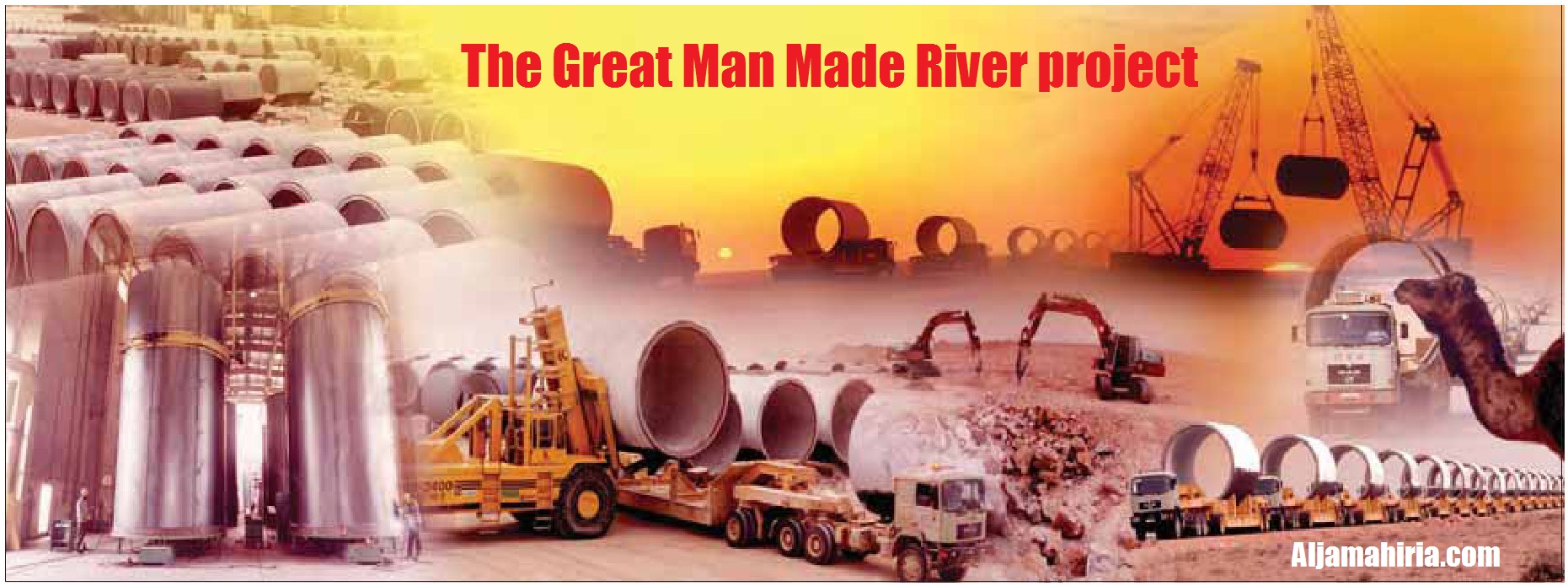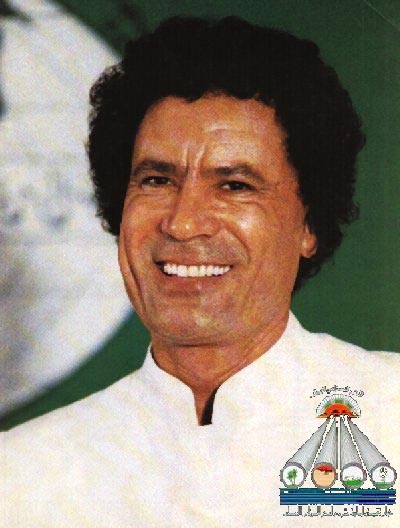Please Donate! Support
AlGaddafi.org
Great Man Made River - لــنهر الصــناعي العظـــيم
Ideas for a greener Libya - Working to provide reliable and safe water supply to support agriculture and cover the domestic water requirements of the Libyan population
العمل على
توفير مصدر دائم وآمن للمياه لدعم المشاريع الزراعية وتغطية
الاحتياجات المائية
للمستهلكين
Great Man Made River (GMMR) - "Великая Рукотворная Река" в Ливии - Das 8. Weltwunder - لــنهر الصــناعي العظـــيم
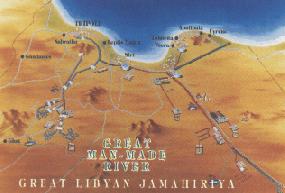
Because of the large
number of Pre-stressed Concrete Cylinder Pipes (PCCP) required for
the implementation of the Great Man Made River Project two plants
were constructed, one at Brega on the north coat of Libya and one
in Sarir deep in the Sahara desert. These plants, which were
commissioned in 1986, are capable of producing various diameters of
pipe ranging from 1.6 meters to 4.0 meters.
Brega
plant with two production lines and Sarir plant with three
production lines have a combined capacity to produce 200 4.0 meter
diameter pipes per day.
- About
GMRA
The Vision
Infrastructure - Pipe Laying
- Pipe
Transportation
Water usage
Facts & Figures
News & events
Announcements
Time line
Contact us
Links
عـــــــربـي
The Infrastructure - The Great Man Made River (GMMR)
Libya
is one of the driest regions of the world with an annual rainfall
ranging from just ten millimetres to 500mm. Just five per cent of
the entire area of Libya exceeds 100mm annually. Evaporation
rates are also high, ranging from 1,700mm in the north to 6,000mm
in the south.
The
leadership of the Great Socialist Libyan Arab Jamahiriya was aware
from
a very
early stage of the impending water shortage crisis in Libya and put
forward a plan that if implemented can be considered as Libya’s
solution to the crisis.
Ground
water is the primary source of freshwater covering 96 per cent of
demand. Studies have shown that aquifer replenishment in the
coastal areas is 500m cubic metres per year. However, this is small
compared to the ever-increasing rate of consumption, which amounts
at present to 4.7bn cubic metres per year. As a result there has
been an intrusion of seawater in the coastal aquifer with a marked
increase in salinity, which has reached 7,000 ppm in the Tripoli
region.
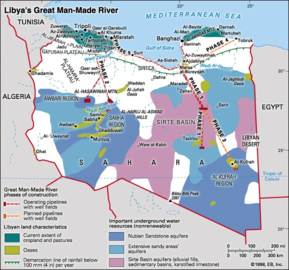
Basins in
Libya:
During
the exploration for oil in the Libyan Desert , investigations have
shown the existence of potentially vast fresh water aquifers, lying
at depths of less than 100 meters below the surface.
There are
four major underground basins in the region. The Kufra Basin covers
an area of 350,000 square kilometres and has an estimated
groundwater storage capacity of 20,000 cubic kilometres in the
Libyan sector. The fresh water aquifer in the Sirt Basin has an
average depth of 600 metres and is estimated to hold over 10,000
cubic kilometres of water. The Murzuk basin, which is estimated to
be 450,000 square kilometres, has an upper aquifer thickness of
around 800 metres and an estimated storage capacity of 4,800 cubic
kilometres. Finally, the Hamadah, which extends from the Qargaf
Arch and Jabal Sawda to the coast, has a capacity of 4000 cubic
kilometres. These basins each contain 2,500-3,000 cubic
kilometres of economically extractable fresh water.
These
basins contain in total 10,000 – 12,000 cubic Km of economically
extractable water
For
optimum use, the country's desert water has to be delivered in very
large quantities, in a manner that can be controlled easily and
which avoids wastage from spillage or evaporation in the intense
summer heat.
Studies were
conducted to establish whether it was more economical to move to
the source of the water in the desert or to convey it to the
existing population centres and it was concluded that the latter
was more viable. In addition to this, comparisons were made to
other water supply alternatives (i.e. desalination, transportation
by water tanker or conveying potable water by pipeline from
southern Europe ) and the results showed that it was more
economical and feasible to convey water from the huge basins in the
desert to the population centres in the north.
Quantity
of Water per Libyan Dinar obtained for each option:
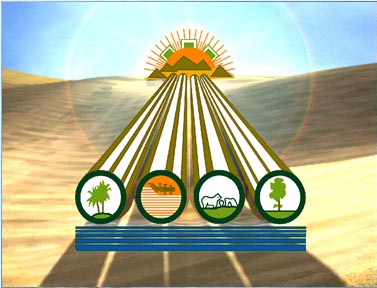
Hence the decisions for the Implementation and funding of The Great Man Made River project were made at the grass roots level by the basic people’s congresses that were then compiled and made into laws by the General Peoples Congress. The project is funded directly by the Libyan people in the form of levies on fuel, tobacco and international travel etc.
